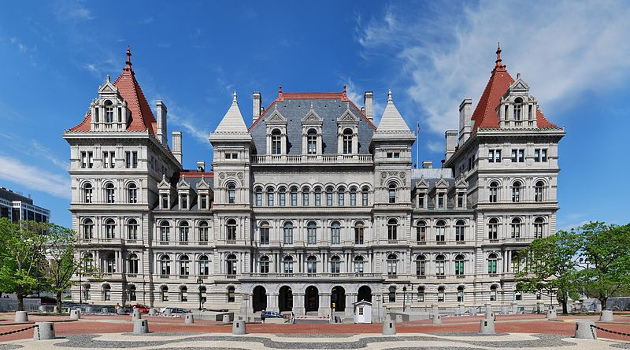New York is ranked dead last for fiscal policy according to Freedom in the 50 States.
 But it’s not the worst state, at least according to the Tax Foundation, which calculates that the Empire State is ranked #49 in the latest edition of the State Business Tax Climate Index.
But it’s not the worst state, at least according to the Tax Foundation, which calculates that the Empire State is ranked #49 in the latest edition of the State Business Tax Climate Index.
Some politicians from New York must be upset that New Jersey edged them out for last place (and the Garden State does have some wretched tax laws).
So in a perverse form of competition, New York lawmakers are pushing a plan to tax unrealized capital gains, which would be a form of economic suicide for the Empire State and definitely cement its status as the place with the worst tax policy.
Here are some excerpts from a CNBC report.
The tax, part of a new “Make Billionaires Pay” campaign by progressive lawmakers and activists, would impose a new form of capital gains tax on New Yorkers with $1 billion or more in assets.
…“It’s time to stop protecting billionaires, and it’s time to start working for working families,” Rep. Alexandria Ocasio-Cortez, D-N.Y., said… Currently, taxpayers pay capital gains tax on assets only when they sell. The new policy would tax any gain in value for an asset during the calendar year, regardless of whether it’s sold. Capital gains are taxed in New York at the same rate as ordinary income, so the rate would be 8.8%.
Given her track record, I’m not surprised that Ocasio-Cortez has embraced this punitive idea.
That being said, the proposal is so radical that even New York’s governor understands that it would be suicidal.
Gov. Andrew Cuomo said raising taxes on billionaires and other rich New Yorkers will only cause them to move to lower-tax states. …“If they want a tax increase, don’t make New York alone do a tax increase — then they just have the people move… Because if you take people who are highly mobile, and you tax them, well then they’ll just move next door where the tax treatment is simpler.”
Actually, they won’t move next door. After all, politicians from New Jersey and Connecticut also abuse and mistreat taxpayers.
Instead, they’ll be more likely to escape to Florida and other states with no income taxes.
In a column for the New York Post, E.J. McMahon points out that residents already have been fleeing.
…there were clear signs of erosion at the high end of New York’s state tax base even before the pandemic. Between 2010 and 2017, according to the Internal Revenue Service, the number of tax filers with incomes above $1 million rose 75 percent nationwide,
but just 49 percent in New York. …Migration data from the IRS point to a broader leakage. From 2011-12 through 2017-18, roughly 205,220 New Yorkers moved to Florida. …their average incomes nearly doubled to $120,023 in 2017-18, from $63,951 at the start of the period. Focusing on wealthy Manhattan, the incomes of Florida-bound New Yorkers rose at the same rate from a higher starting point— to $244,936 for 3,144 out-migrants in 2017-18, from $124,113 for 3,712 out-migrants in 2011-12.
What should worry New York politicians is that higher-income residents are disproportionately represented among the escapees.
And the author also makes the all-important observation that these numbers doubtlessly will grow, not only because of additional bad policies from state lawmakers, but also because the federal tax code no longer includes a big preference for people living in high-tax states.
These figures are from the period ending just before the new federal tax law temporarily virtually eliminated state and local tax deductions for high earners, raising New York’s effective tax rates higher than ever. …soak-the-rich tax sloganeering is hardly a welcome-home signal for high earners now on the fence about their futures in New York.
The bottom line is that it’s a very bad idea for a country to tax unrealized capital gains.
And it’s a downright suicidal idea for a state to choose that perverse form of double taxation. After all, it’s very easy for rich people to move to Florida and other states with better tax laws.
And since the richest residents of New York pay such a large share of the tax burden (Investor’s Business Daily points out that the top 1 percent pay 46 percent of state income taxes), even a small increase in out-migration because of the new tax could result in receipts falling rather than rising.
Another example of “Revenge of the Laffer Curve.”
———
Image credit: Matt Wade Photography | CC BY 3.0.

